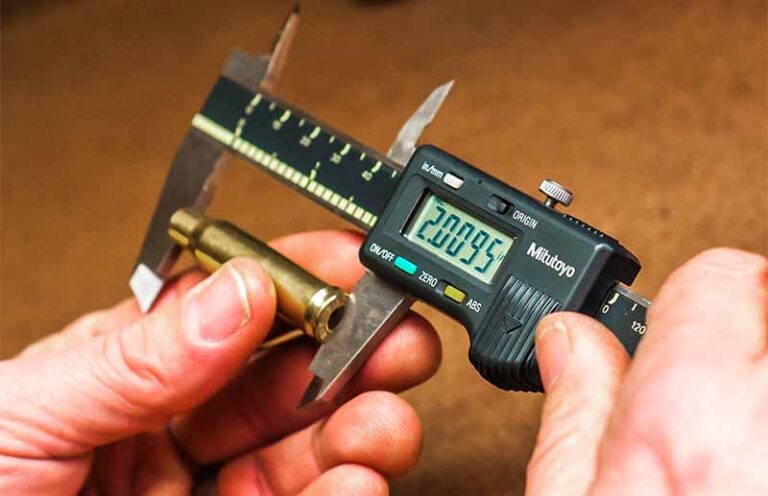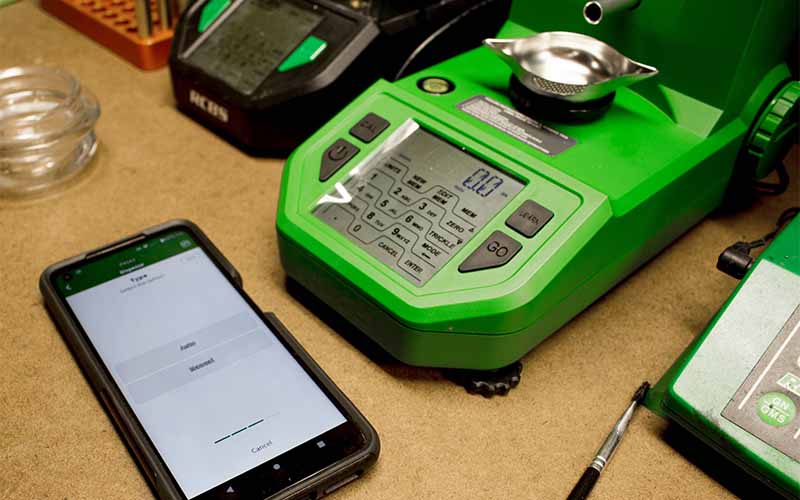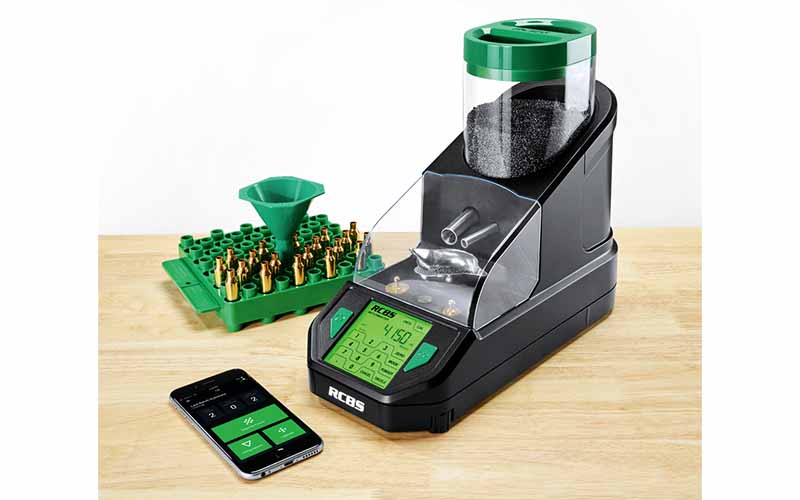
From powder dispensers to case prep to calipers, should you be using “digital” reloading tools?
Ol’ Grumpy Pants came over to the shop with a bag full of spent .22-250 Remington brass, intending to load ammunition. Dad, who taught me how to reload decades ago, just looked over his nose as I warmed up the RCBS ChargeMaster Link, while using the Universal Case Prep Station to trim the cases to the proper length.
Turning off the loud rotary trimmer, I checked the case dimensions with my Mitutoyo digital caliper and used my phone to have the electronic dispenser throw the proper amount of Hodgdon’s H380 powder. Feeling that familiar stare on the back of my head, I stopped to ask him just what he was gawking at.

“When I started doing this, I didn’t have a single piece of gear that required an outlet or a battery,” he said. “What the hell is all this crap?”
Now, I’ll be the first to admit my father no longer readily embraces modern technology—though there was a time when he did. But, I will also admit that the tool set we had when I first learned to reload was much less sophisticated than what’s on my bench currently, and the dichotomy is glaring.
Though my days of plastic scoops, dispensing powder into the pan of a balance beam scale and using an analog dial caliper for measuring seem to be in the past, there’s nothing wrong with those tools. And I will also say that I truly appreciate the advances in modern “digital” tools.
Today’s Reloader
The modern reloader generally falls into one of two camps: those trying to save money on ammunition (usually to shoot more, for less) and those who will spend whatever money is needed to make the best ammunition possible. When I was a young man, I definitely fell into the former—though once I went down the rabbit hole, I began to identify with the latter, though I can’t find fault with either mindset.
But for those skeptical about digital tools, flashing lights, beeping powder dispensers and electric motors spinning their cutting attachments, let me alleviate your worries herein: You can, if you choose, continue to use all hand-powered tools.
Case Prep
I still have a Redding Model 2400 piloted case trimming lathe on my bench, and with its precision adjustments, I can put the elbow grease to good work for a consistent result. Or, a tool like the RCBS Universal Case Prep Station uses a variable speed electric motor to spin the cutting head for the micrometer-adjustable case trimmer—as well as the half-dozen threaded attachment ranging from primer pocket brushes, primer pocket reamers (in both large and small sizes) to chamfer and de-burring tools. It isn’t exactly a digital wonder, but it does represent a technological leap, at least in the bursitis department.
Powder Dispensers
That RCBS ChargeMaster Link—or even better, the MatchMaster—powder dispenser is, however, a quantum leap in powder dispensing. Both are programmable, both dispense powder very precisely (though the MatchMaster is the most precise machine I’ve ever used) and both can be operated from a smartphone. If you don’t own a smartphone, and I know many guys who don’t, you can manually program the dispensers to make your life easier. Even the older ChargeMaster Lite, or the original ChargeMaster 1500, can be a great leap over a manual powder thrower and trickler, at the very least saving the reloader precious time at the bench.

Digital Scales
The digital scales built into these units are utterly reliable—though I cannot say the same for other brands—and I’ve been testing them for a decade against my nest balance beam scales. Does this mean I've set the balance beam scales back in their boxes? No, that isn’t the case. I love a system of checks and balances, and I also know that a balance beam scale isn’t as easily influenced by atmospheric conditions or its surroundings.

The electronic scales can go awry if you’ve got a fan running in the room—they don’t like breezes in the least—and some folks swear that fluorescent lighting influences them, but that hasn’t been my finding.
If time is a commodity (and when isn’t it?), electronic dispensers will most definitely increase your output without cutting corners. Unless you’re currently weighing each powder charge on a balance beam scale, I’d also wager you’ll see more consistent results at the shooting bench, as the dispenser weighs each charge down to 1/10th grain, or less in some instances.
Calipers
My machinist friends wrinkle their noses at the sight of a digital caliper, as only a premium-quality analog caliper is good enough for their profession. For my purposes—at the reloading bench—a digital caliper is precise enough to make premium ammunition. I use a Mitutoyo CD-6 CS for most of my work, just because it has become an old friend, but I also have an RCBS Electronic Digital Caliper, which works just as well for me. Both have the handy feature of switching between inches (and decimal portions of an inch, out to 0.0005 inch) and millimeters (to 0.01 mm), and both measure out to just over 6 inches, which is more than enough for the average reloader.

Sometimes I feel that the handwork and elbow grease of case preparation is therapeutic; if that works for you as well, so be it. There are times where I prefer the hands-on approach, using my Little Crow Gunworks Precision Prep Tool to put the perfect VLD chamfer on the inside of the case mouth, giving special attention to removing all the burrs on the outside of the mouth, or hand-tuning a primer pocket to get that perfect primer seat for match-grade ammo.
There are also times where I appreciate the efficiency of the rhythmic pattern developed by the ChargeMaster Link, throwing a precise charge in as much time as it takes me to dump the charge into the case and seat the bullet. The cartridge count of the machine allows me to assure myself that each cartridge made got a powder charge, and though I may weigh those electronically measured charges on a balance beam scale every now and again, I’ve completely come to grips with the fact that the digital reloading tools are a benefit to us all.
Now, Ol’ Grumpy Pants, on the other hand, is a tougher nut to crack.
Editor's Note: This article originally appeared in the March 2023 issue of Gun Digest the Magazine.
More On Reloading:
- Tips For Reloading the .30-06 Springfield
- Loving Your Luger: Reloading the 9mm Luger
- Handloading: Tips For Reloading The 7mm Rem Mag
- How To: Tips For Reloading the .223 Remington
- Reloading Bench: The Inside On Reloading For The .30-30 Winchester

Next Step: Get your FREE Printable Target Pack
Enhance your shooting precision with our 62 MOA Targets, perfect for rifles and handguns. Crafted in collaboration with Storm Tactical for accuracy and versatility.
Subscribe to the Gun Digest email newsletter and get your downloadable target pack sent straight to your inbox. Stay updated with the latest firearms info in the industry.

![Best Concealed Carry Guns In 2025 [Field Tested] Wilson Combat EDC X9S 1](https://gundigest.com/wp-content/uploads/Wilson-Combat-EDC-X9S-1-324x160.jpg)


![Best 9mm Carbine: Affordable PCCs [Tested] Ruger Carbine Shooting](https://gundigest.com/wp-content/uploads/Ruger-Carbine-Shooting-100x70.jpg)
![Best AR-15: Top Options Available Today [Field Tested] Harrington and Richardson PSA XM177E2 feature](https://gundigest.com/wp-content/uploads/Harrington-and-Richardson-PSA-XM177E2-feature-100x70.jpg)
